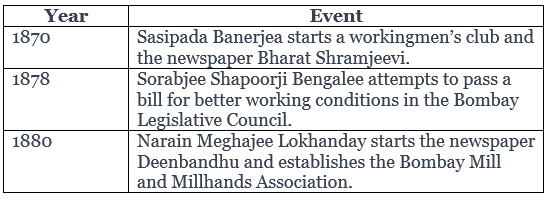Cheat Sheet: The Movement of the Working Class | History for UPSC CSE PDF Download
Introduction
The early nationalist period in India witnessed the emergence of various social and political movements. Among these, the labor movement played a crucial role, with notable contributions from individuals and organizations advocating for workers' rights. This chronology document aims to outline key events in the early efforts of the Indian working-class movement, especially focusing on the Moderates, the formation of trade unions, and significant milestones leading up to and following India's independence.
Early Nationalists and the Labor Movement

In the early years, pioneers like Sasipada Banerjea, Sorabjee Shapoorji Bengalee, and Narain Meghajee Lokhanday laid the groundwork for the labor movement through the establishment of workingmen's clubs, newspapers, and associations.
The First Workers' Strike and Swadeshi Upsurge

The late 19th century witnessed the first significant strike by railway workers, gaining momentum during the Swadeshi movement when workers engaged in wider political concerns.
The Formation and Legislation of Trade Unions

The 1920s marked the formalization of trade unions with the establishment of AITUC and the enactment of the Trade Union Act, providing legal recognition and regulation for these organizations.
The TDA, Meerut Conspiracy Case, and Post-Independence Developments

The late 1920s witnessed the introduction of the TDA, the Meerut Conspiracy Case, and post-independence polarization within the working-class movement.
Conclusion
The chronology above traces the evolution of the Indian working-class movement, emphasizing the early efforts, trade union formations, and key events during and after independence. These milestones reflect the labor movement's resilience and its role in shaping India's socio-political landscape. The journey from the early pioneers to post-independence polarization underscores the complex interplay between labor, politics, and societal changes in India's history.
|
110 videos|653 docs|168 tests
|
FAQs on Cheat Sheet: The Movement of the Working Class - History for UPSC CSE
| 1. What were the early nationalist movements in India and their impact on the labor movement? |  |
| 2. What was the significance of the first workers' strike and Swadeshi upsurge? |  |
| 3. How were trade unions formed and what legislation supported their formation? |  |
| 4. What were the TDA, Meerut Conspiracy Case, and their impact on the labor movement? |  |
| 5. How did the labor movement evolve after independence in India? |  |
















